Table of Contents
Introduction
Datafication Statistics: In the Information Age, datafication, converting various aspects of our lives, activities, and environments into digital data. It represents a seismic shift in how we perceive, collect, process, and leverage information.
This transformation of the tangible and intangible into measurable datasets is rooted in the historical evolution of computing and digitalization and is of paramount importance in the digital age.
Datafication empowers informed decision-making, fuels innovation, drives economic growth, and leads to societal and cultural shifts. It is a fundamental force shaping modern society and unlocking a future brimming with possibilities.
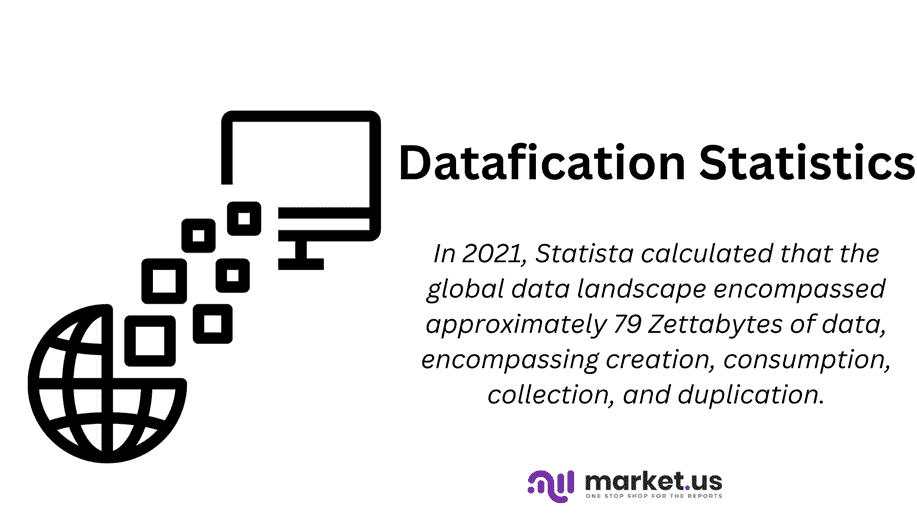
Editor’s Choice
- In 2023, the datafication market revenue is expected to reach USD 320 billion,
- Based on an estimate, a staggering 1.145 trillion megabytes of data are generated daily.
- In 2021, Statista calculated that the global data landscape encompassed approximately 79 Zettabytes of data, encompassing creation, consumption, collection, and duplication.
- Per the predictions in the Data Scientist Report by CrowdFlower. Text data constitutes 91% of the data employed in data science.
- The same survey also disclosed that unstructured data comprises 33% images, 11% audio, 15% video, and 20% other data types alongside text.
- The worldwide datasphere comprises 90% replicated data and 10% unique data.
- Globally, 80% to 90% of data is unstructured, as reported in a CIO article.
- To put things into perspective, today’s internet users would require an astounding 181 million years to download the entire internet’s data.
- In 2020, LinkedIn welcomed approximately two new members every second. The United States became the world’s leading data center hub in 2021, boasting 2670 data centers.
- In 2020, according to data from Domo, every individual generated nearly 2.5 quintillion bytes of data daily. The same report from Domo revealed that, in 2020. Each person was responsible for approximately 1.7 MB of data generated every second.
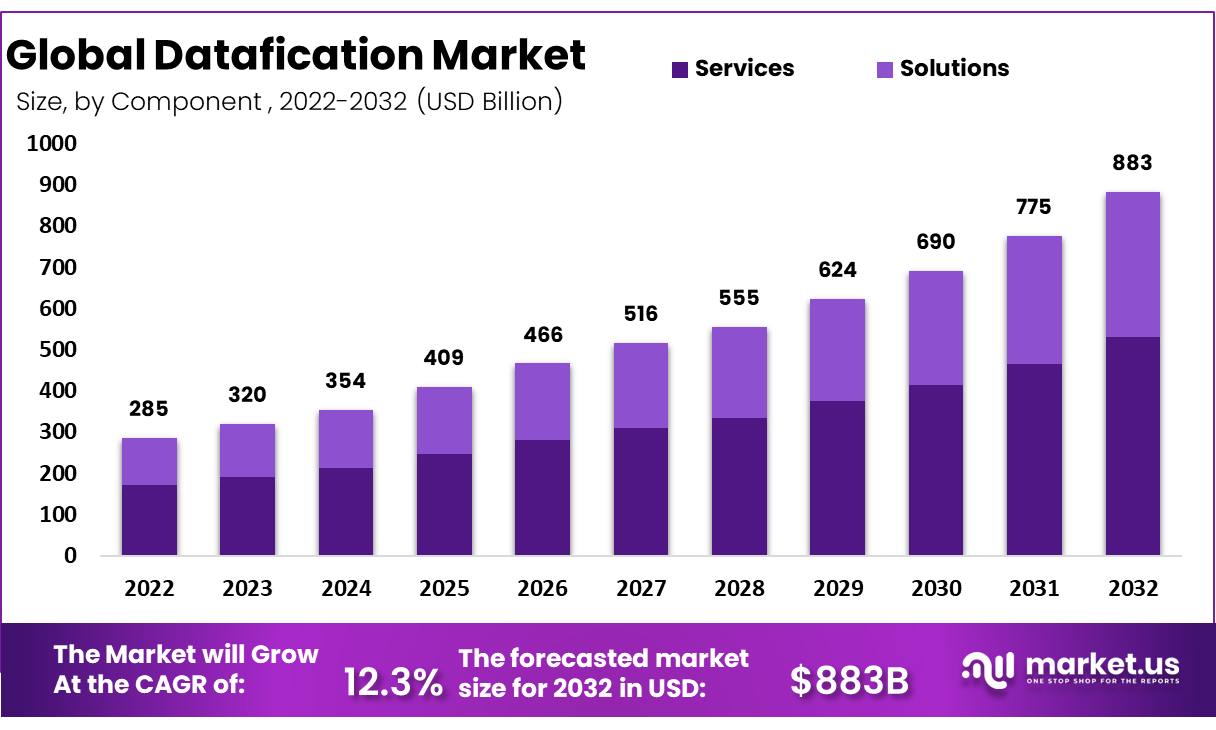
Datafication Market Size Statistics
- The datafication market has exhibited a remarkable growth trajectory at a CAGR of 12.3%. With its revenue in 2022 amounting to USD 285 billion and projecting substantial expansion over the next decade.
- In 2023, the market revenue is expected to reach USD 320 billion, followed by further increases in the subsequent years. Reaching USD 354 billion in 2024 and surging to USD 409 billion in 2025.
- As we move towards 2030, the datafication market is anticipated to grow significantly. With projections indicating revenue figures of USD 466 billion in 2026. USD 516 billion in 2027, and USD 555 billion in 2028.
- The growth trend is expected to continue into the late 2020s and early 2030s. With revenue estimates reaching USD 624 billion in 2029, and USD 690 billion in 2030. A substantial USD 775 billion in 2031, ultimately culminating in an impressive USD 883 billion by 2032.
- This data underscores the increasingly vital role of datafication in the global economy. Reflecting its enduring upward trajectory and continued influence across industries.
(Source: Market.us)

Market Size – By Component Datafication Statistics
- The global datafication market, when broken down by component, reveals a dynamic landscape characterized by robust revenue growth.
- In 2022, the total revenue in this sector stood at USD 285 billion. With services accounting for USD 171 billion and solutions contributing USD 114 billion.
- Over the subsequent years, this trend is expected to continue its upward trajectory. Reflecting the expanding role of datafication across various industries.
- By 2023, the total revenue is projected to rise to USD 320 billion. With services generating USD 192 billion and solutions yielding USD 128 billion.
- The growth persists, with 2024 estimates reaching USD 354 billion. Comprising USD 213 billion from services and USD 142 billion from solutions.
- As we progress to 2025 and beyond, the datafication market is set to soar. With the total revenue surging to USD 409 billion in 2025, USD 466 billion in 2026, and USD 516 billion in 2027.
- The division between services and solutions is similarly dynamic. With services revenue projected to reach USD 310 billion in 2027 and solutions contributing USD 206 billion.
- This trend continues its impressive trajectory, culminating in total revenue of USD 883 billion by 2032. Services and solutions account for USD 530 billion and USD 353 billion, respectively.
- These figures underscore the vital role of services and solutions in the expanding datafication market, indicating their enduring impact on the global economy.
(Source: Market.us)
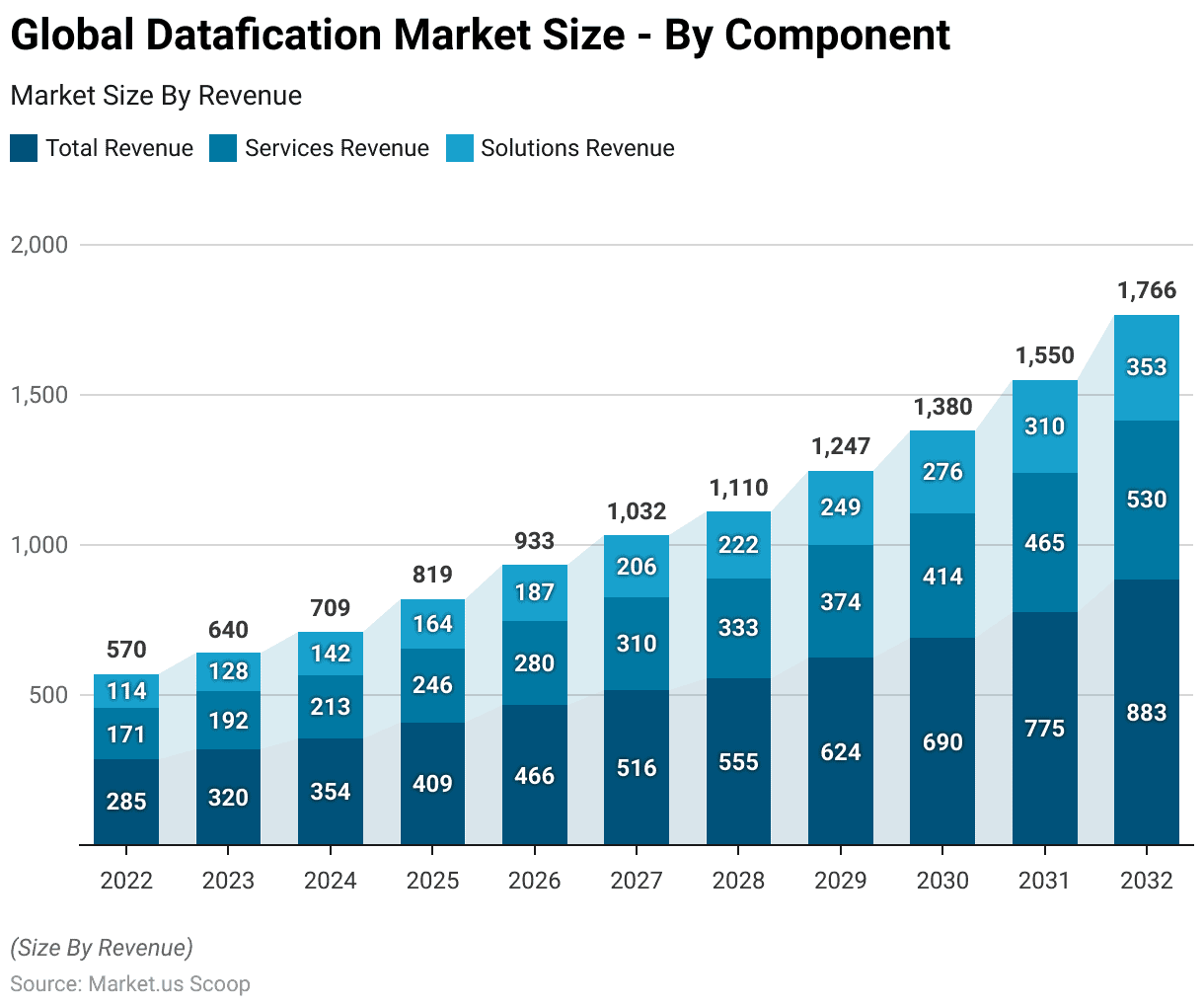
Datafication Market Share- By End-use Industry Statistics
- The global datafication market is distributed across various end-use industries, each contributing to its dynamic landscape.
- In 2022, the BFSI (Banking, Financial Services, and Insurance) sector held the largest market share, accounting for 33% of the total market.
- The healthcare industry closely followed, with a significant 21% share. Emphasizing the growing importance of data-driven solutions in the healthcare sector.
- The IT and Telecom sector contributed 15% to the market share, showcasing the technological underpinnings of datafication.
- Government agencies held an 11% share, reflecting the adoption of data-driven approaches in public administration.
- Retail and education industries constituted 9% and 7% of the market share, respectively. Illustrating their embrace of datafication for enhanced operations and services.
- Other end-users collectively accounted for 4% of the market share, signifying a range of industries utilizing datafication solutions.
- This market share distribution emphasizes the widespread applicability of datafication across diverse sectors. With each industry playing a pivotal role in shaping the global data-driven landscape.
(Source: Market.us)
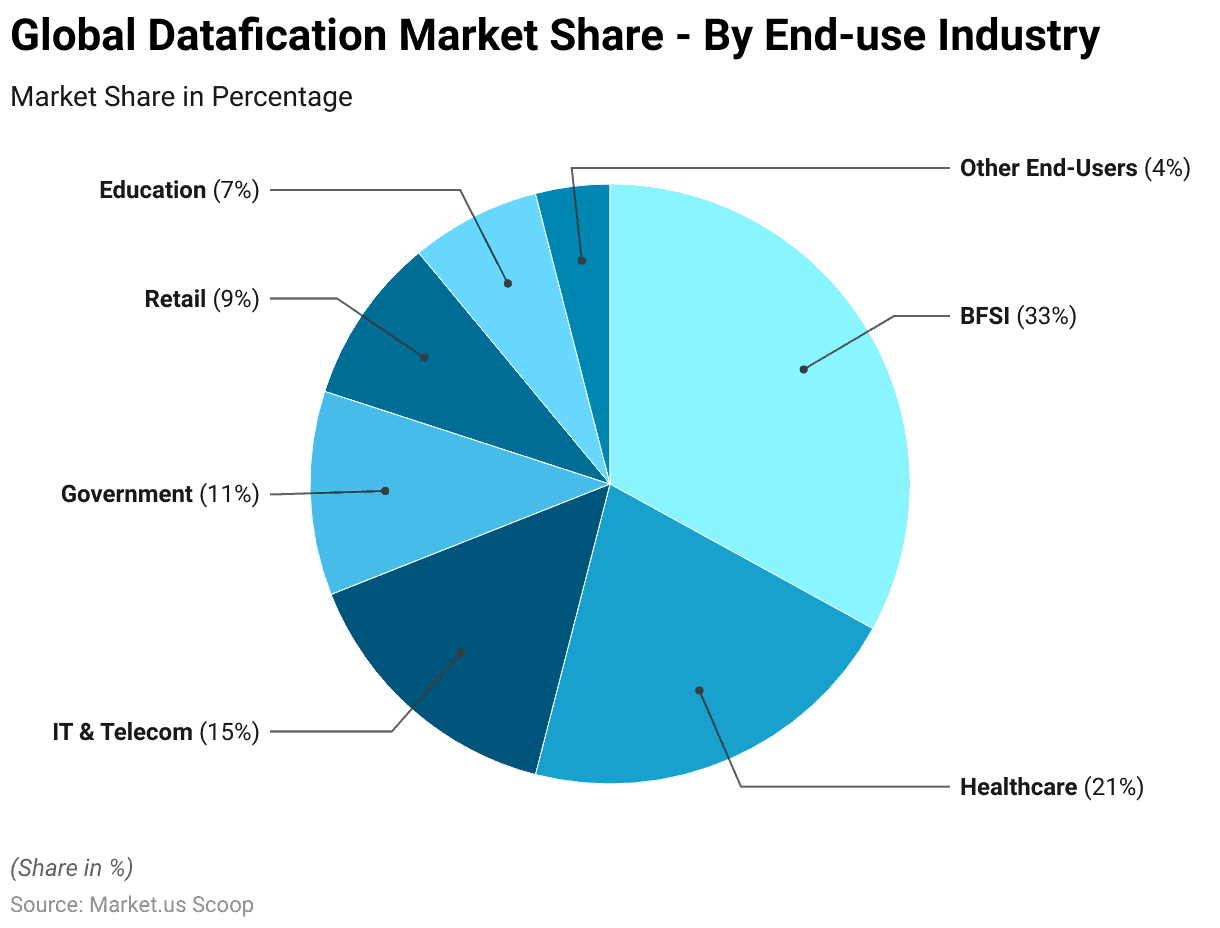
Sources and Types Datafication Statistics
Real-time/ Live Streaming Datafication Statistics
- The entertainment industry has witnessed a surge in the popularity of live streaming, particularly driven by the gaming world. In the third quarter of 2022, leading platforms within this sector recorded an astonishing 7.2 billion hours of content watched.
- Notably, users have embraced this format even in professional contexts, with an estimated 40% of marketing managers and directors anticipating that 40% of the marketing events they participate in during 2022 will be entirely virtual.
- Although video consumption has stabilized following the peak observed during the global COVID-19 pandemic in 2020. Social media platforms have recognized users’ growing familiarity with live streaming.
- Research commissioned by the well-known social video platform TikTok revealed that more than 52% of its global user base expressed interest in consuming live branded content.
- China’s Alibaba and the short-video app Douyin pioneered online live e-commerce, which saw remarkable growth. Live video streaming made its first foray beyond the Asia-Pacific region in 2020 and 2021.
- However, a mere 3% of global respondents in April 2022 regarded social media platforms as the best channels for online purchases.
- In early 2022, Facebook and Instagram from Meta were prominent in live streaming purchases. But Facebook ceased its live shopping feature in October 2022.
- YouTube, in contrast, expanded its shopping features and partnered with Shopify in July 2022, enabling “shoppable content” with creators and brands ahead of the holiday season.
- Similarly, 72% of global users are interested in branded content and product sales. TikTok introduced live shopping in the United States in October 2022.
(Source: Statista)
IoT and Sensor Data Datafication Statistics
- The IoT (Internet of Things) sensors market has witnessed substantial growth and fluctuations in revenue over the past few years.
- In 2018, the market generated approximately USD 5.28 billion in revenue, reflecting the early stages of IoT sensor adoption.
- The following year, in 2019, the market revenue almost doubled, reaching USD 11.91 billion, underlining the rapid expansion in IoT applications.
- However, it’s worth noting that data for the year 2020 is not included here. By 2021, the IoT sensors market had further expanded, recording revenue of USD 21.8 billion, demonstrating the increasing integration of IoT technologies into various sectors.
- The momentum continued into 2022, with market revenue growing to USD 27.4 billion, indicating sustained growth.
- Looking ahead, projections for 2024 estimate a slight dip in revenue to USD 23.82 billion but expect a significant resurgence in 2025, with the market revenue reaching USD 42.67 billion.
- These figures reflect the dynamic nature of the IoT sensors market, characterized by both rapid growth and fluctuations, as IoT technologies continue to shape the future of connectivity and data collection.
(Source: Statista)

Social Media and Web Data Datafication Statistics
- In 2022, about half of social media users utilized these platforms to stay connected with loved ones. Other popular reasons included leisure, finding inspiration, and keeping up with the news.
- Social media has become a crucial news source in many nations, with over 70% of adults in countries like Nigeria, Thailand, Malaysia, and South Africa turning to it for news updates.
- Over the past decade, the time spent on social media has consistently risen, reaching an average of 151 minutes per day in 2023.
- Toward the close of 2021, Facebook Ltd rebranded as Meta Platforms Inc, emphasizing the metaverse.
- The Meta Family of Apps, which includes Facebook, Instagram, Messenger, and WhatsApp, contributed to a revenue exceeding $116 billion in 2022.
- Facebook, boasting nearly three billion monthly active users as of Q1 2023, maintains its status as one of the most prosperous global social networks, a trend sustained for over a decade.
- Instagram, originally known for its aesthetically pleasing images and celebrity insights, has witnessed shifts in user preferences.
- In early 2023, more than 50% of Instagram users enjoyed humor-based posts, while 46% preferred creative content.
- Although Instagram achieved a significant milestone in December 2021, amassing approximately two billion monthly users, it still lags behind Facebook’s user base.
(Source: Statista)
Government and Open Data by Datafication Statistics
- In 2020, there was a notable increase in key features associated with open government data (OGD) portals in countries worldwide compared to 2018.
- The share of countries with national OGD portals surged from 47% to 79%, highlighting a significant expansion in providing access to government data.
- However, the presence of national OGD policies saw a slight decline, dropping from 64% to 59%.
- Meanwhile, essential features such as having metadata or a data dictionary, accepting public requests for new datasets, and offering guidance on using OGD remained relatively stable, with modest increases in some cases.
- While still prevalent, engagement in promotional efforts, like data hackathons, decreased slightly from 53% to 49%.
- These statistics illustrate the evolving landscape of OGD features, with governments increasingly recognizing the value of open data portals to enhance transparency and public engagement.
(Source: Statista)
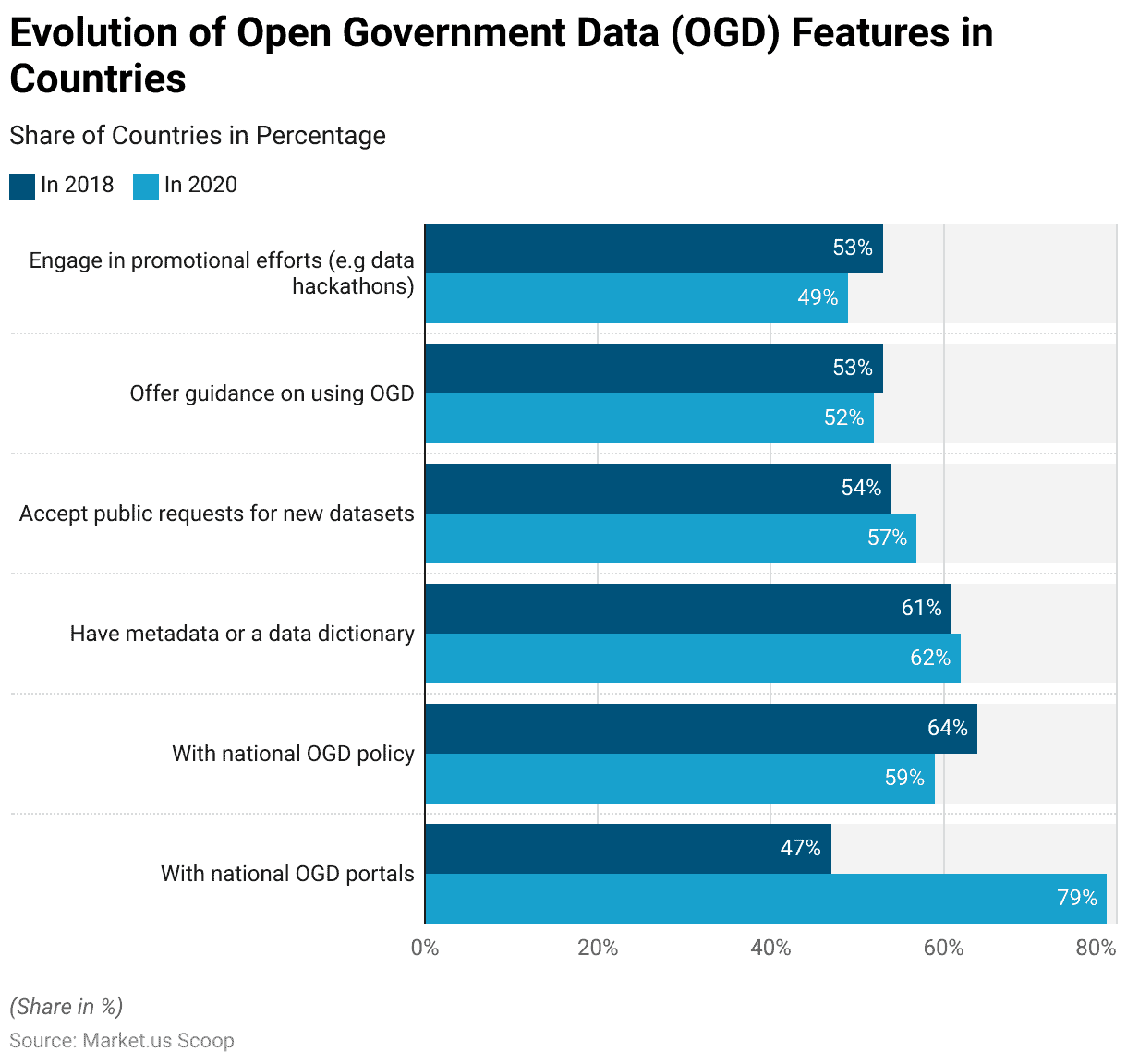
Data Privacy Concerns Datafication Statistics
- Most adults worldwide, accounting for 85%, express a strong desire to take more measures to safeguard their online privacy.
- A significant 80% voice their concerns about the security of their privacy, with 69% noting an increasing unease regarding this matter.
- However, 61% admit to willingly compromising their data privacy for convenience.
- Additionally, 55% believe that achieving complete privacy protection is an unattainable goal, while 51% confess to lacking knowledge about securing their privacy effectively.
- Many individuals prioritize online privacy in the United States, with 75% acknowledging cyberattack vulnerability.
- Despite this awareness, there is a notable disparity between this awareness and action, as only 64% employ tools to enhance their online privacy, and a mere 56% feel they maintain control over their data.
- The vast majority, amounting to 87%, favor prohibiting the sale of user data to third parties unless users grant their explicit consent.
- An impressive 86% endorse mandating companies to limit the categories of user data they gather.
- Similarly, 86% support bolstering online privacy regulations for individuals under 17.
- Furthermore, 82% favor granting individuals the legal right to pursue compensation following data breaches.
(Source: Norton, Morning Consult)
Recent Developments
Acquisitions and Mergers:
- Microsoft acquires Nuance Communications: In 2023, Microsoft completed its $19.7 billion acquisition of Nuance Communications, a leader in AI and speech recognition. This acquisition aims to enhance Microsoft’s data-driven healthcare solutions by leveraging Nuance’s expertise in the datafication of medical records.
- Salesforce acquires Tableau: Salesforce finalized its $15.7 billion acquisition of Tableau in late 2022. This merger is designed to integrate Tableau’s powerful data visualization tools with Salesforce’s customer relationship management (CRM) platform, enabling more comprehensive data insights.
New Product Launches:
- Google Cloud’s DataFusion: In mid-2023, Google Cloud launched DataFusion, a fully managed data integration service that helps businesses aggregate and analyze data from multiple sources, enhancing datafication processes and decision-making capabilities.
- IBM Watson Works: IBM introduced Watson Works in early 2024, a suite of AI-driven applications designed to help organizations manage workplace safety, operational efficiency, and health data by leveraging datafication techniques.
Funding:
- Snowflake raises $1.4 billion: In 2023, Snowflake, a cloud-based data warehousing company, raised $1.4 billion in a funding round to expand its datafication and data analytics capabilities, aiming to support more industries and use cases.
- Palantir secures $600 million: Palantir Technologies, known for its big data analytics platforms, secured $600 million in early 2024 to enhance its datafication tools and services, particularly for government and large enterprises.
Technological Advancements:
- AI and Machine Learning in Datafication: Advances in AI and machine learning are significantly improving datafication processes, enabling more accurate data extraction, transformation, and analysis from diverse data sources.
- Blockchain for Data Integrity: Blockchain technology is being increasingly used to ensure the integrity and security of data in datafication processes, providing immutable and transparent data records.
Market Dynamics:
- Growth in Datafication Market: The global datafication market is projected to grow at a CAGR of 22% from 2023 to 2028, driven by the increasing need for data-driven decision-making across various industries.
- Adoption in Healthcare: The healthcare sector is rapidly adopting datafication techniques to improve patient outcomes, streamline operations, and enhance research capabilities, with significant investments in health data analytics.
Regulatory and Strategic Developments:
- GDPR and Data Privacy Regulations: Data privacy regulations like the GDPR are impacting datafication strategies, requiring companies to implement robust data governance practices to ensure compliance and protect user data.
- Data Sovereignty Laws: Governments are enacting data sovereignty laws that require data to be stored and processed within national borders, affecting how multinational companies approach datafication.
Research and Development:
- Advanced Data Analytics Techniques: Ongoing research in advanced data analytics techniques, such as predictive analytics and real-time data processing, is enhancing the capabilities and applications of datafication.
- Datafication in Smart Cities: R&D efforts are focusing on applying datafication in smart city initiatives, utilizing data from IoT devices to improve urban planning, traffic management, and public safety.
Conclusion
Datafication Statistics – Datafication is a powerful force in our contemporary world, transforming various aspects of our lives into digital information.
This transition is closely linked to the historical advancement of digital technology and computing. Datafication brings numerous benefits, such as supporting informed decision-making, driving innovation, and spurring economic progress.
However, it raises significant concerns concerning privacy, security, and ethical data usage. Datafication will continue to be a central player in shaping our society, presenting fresh opportunities and challenges.
To navigate this landscape effectively, it is crucial to balance the advantages and drawbacks of this data-centric paradigm.
FAQs
Datafication transforms various aspects of our lives, activities, and environments into digital data. It involves converting tangible and intangible phenomena into measurable and analyzable datasets.
Datafication has numerous applications, including personalized marketing, healthcare monitoring, predictive maintenance, and smart city initiatives. It is used in various industries to make data-driven decisions and gain insights from the data generated.
Datafication empowers informed decision-making, fuels innovation, drives economic growth, and enhances efficiency. It allows for better-targeted services and improved user experiences.
Datafication raises issues related to data privacy, security, and the ethical use of data. It can lead to potential breaches, surveillance, and discrimination based on data analysis.
Datafication can compromise privacy when personal information is collected, analyzed, and shared without the individual’s knowledge or consent. It raises concerns about data misuse and unauthorized access.
Discuss your needs with our analyst
Please share your requirements with more details so our analyst can check if they can solve your problem(s)



